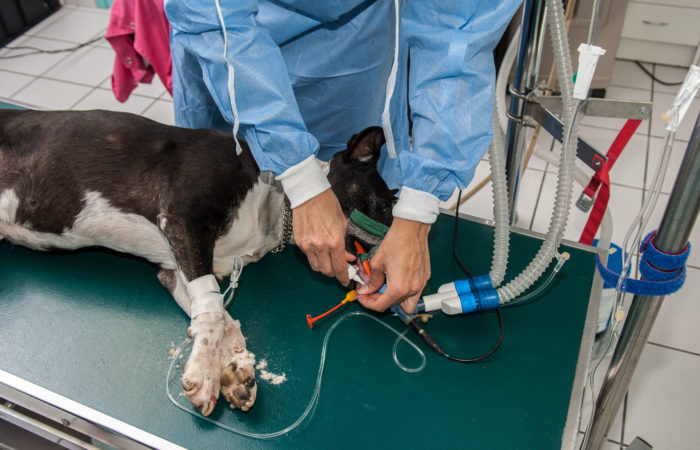Small Animal Respiratory Disease… Don’t hold your breath?
Do you want to improve your diagnosis and management of small animal respiratory disease cases? Small animal respiratory diseases can be both stressful and frustrating to manage. Clinical signs of respiratory disease can range from life threatening to infuriatingly chronic in nature. This veterinary thought exchange online tutored course will present a problem-based, interactive approach to several common manifestations of respiratory disease in dogs and cats. The course also provides an update on a range of diagnostic and therapeutic techniques for managing respiratory cases. You will not only be able to optimise your management of respiratory cases in primary-care practice, but will also grow in confidence when making diagnostic and treatment plans for dogs and cats with respiratory disease.
The course is run by our very own Scott Kilpatrick (EBVS and RCVS Recognised Specialist in Small Animal Internal Medicine) and Liz Bode (EBVS and RCVS Recognised Specialist in Cardiology). Scott and Liz are joined by a variety of amazing specialist speakers from across the veterinary profession, talking on topics including: internal medicine, cardiology, anaesthesia & analgesia, soft tissue surgery, ECC and clinical pathology. It runs over a 16-week period and takes around 20 hours to complete. The course is delivered via video webinars and supplemented with discussion forums and live chats with the course tutor, giving you the opportunity to ask questions or discuss cases you may be facing in your practice.
Access to this course is for 12 months from the start of the course going live on our website. If you sign up to the course after the live sessions have run, you will still be able to access the recordings from the live sessions. The discussion forum will be monitored for the course duration only.
Course Content
- Identify aspects of the history and clinical examination that will direct your diagnostic procedures
- Describe various diagnostic tests and their utility in different situations
- Consider what therapy might be most effective and why
- Understand how to best utilise diagnostic tools in the emergency setting
- Describe the identification of patients with cardiac disease
- Assimilate the best management strategies for these patients
- Understand the many causes of non-cardiac related dyspnoea with a focus on pleural space disease
- Learn about the practical elements of airway sampling and the placement of chest drains
- Discuss a logical case-based approach to the dyspnoeic cat
- Describe the various considerations that are needed to anaesthetise patients with respiratory disease
- Explain how monitoring of these patients can improve outcomes and how to interpret the information
- Understand the challenges that respiratory cases provide the anaesthetist
- Describe the normal ultrasonographic anatomy of the thorax
- Identify pathology of the thorax as it appears on ultrasound
- Formulate a differential list for any abnormalities identified
- Describe the normal radiographic thoracic anatomy
- Describe and identify lung patterns.
- Identify disease associated with the pleural space radiographically.
Join us for this unique round table discussion about the challenges of BOAS patients. When to anaesthetise them and how? Do they all need omeprazole. When does their airway need addressing?
- Discuss the logical approach to cases presenting with sneezing or nasal discharge
- Understand the best approach to imaging and sample collection from the nasal passages
- From Aspergillosis to Bordetella… what are the best treatment options?
- Understand the common causes of laryngeal and tracheal disease
- Discuss the challenges of imaging these patients… is CT the only way?
- Describe the surgical and medical options for treatment in these cases
- List the options for airway sampling and describe the top tips for obtaining a good quality bronchioalveolar lavage
- Describe the common causes of bronchial disease
- Identify the most up to date treatment options… steroids are not the only option
- Learn about common diseases of the pulmonary parenchyma, with a particular focus on bronchopneumonia
- Discuss the challenges of aspiration pneumonia… are antibiotics really required?
- List other differentials… from fibrosis to leptospirosis
- Describe the clinical signs and history that might be associated with pulmonary hypertension
- List the diagnostic tests available to us and how we determine whether pulmonary hypertension is present or not
- Discuss the benefits of a variety of treatment strategies in these patients
- Describe the common presenting signs associated with Angiostrongylus
- List the diagnostic tests available and when to use which one
- Formulate appropriate treatment and management strategies for these cases
- Consider the presenting signs of patients with lung cancer; Animals can be presented for cough, haemoptysis, panting, or other signs of respiratory dysfunction
- Learn about the most effective treatment options that are available
- Consider the investigation of paraneoplastic conditions such as hypertrophic osteopathy or polyneuropathy
- Learn about the indications for tracheostomy tube placement and the practical elements of placement
- Discuss the practical elements if thoracic drain placement
- Consider a logical approach to these cases
- Your chance to discuss any cases you are struggling with.
- We will bring along a few interesting cases too!
- Ask the questions you have always wanted to ask!
Meet the speakers
show
already purchased this course? login to your vtx account for access
login






